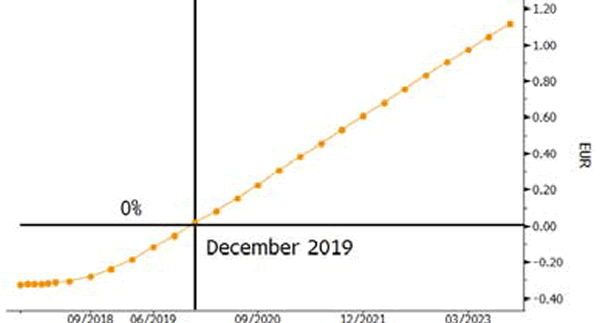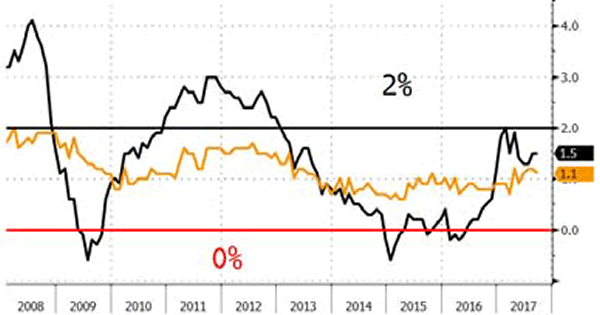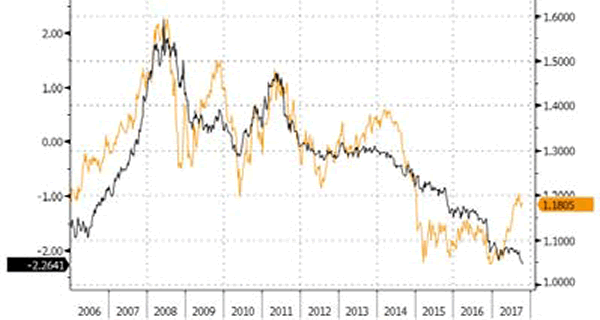- APP: consensus about 9-month extension at €30 bn/month from January
- Markets too complacent about a more hawkish outcome, such as a shorter lifespan APP?
- Accelerating growth, strengthening jobs market, but tame inflation give ECB room for maneuver
- Curve steepening, but what about EUR/USD?
The ECB indicated that at last month’s governing council policy meeting there were ‘very preliminary’ discussions on various topics relating to the winding down and eventual exit from QE. These remained mostly confined to asking questions about the pros and cons of various scenarios entailing different extension lengths and purchase amounts that might be considered in the future. This week’s ECB policy meeting is expected to deliver significant clarity about the future of the central bank’s Asset Purchase Programme with the end-date looming on the horizon. The current forward guidance reads that “net asset purchases, at the current monthly pace of €60 billion, are intended to run until the end of December 2017, or beyond, if necessary, and in any case until the Governing Council sees a sustained adjustment in the path of inflation consistent with its inflation aim.”
APP: Extend and recalibrate
Ahead of the September meeting, we suggested that the ECB could use the playbook they’ve put together in December 2016. Ten months ago, the central bank was in a more or less similar situation as the APP guidance noted that purchases were intended to run until the end of March 2017, or beyond, if necessary. The ECB then decided to lengthen asset purchases, but also to “recalibrate” the monthly amount (from €80bn/month to €60bn/month) in order to adapt to the changing/improving economic reality
More specifically, we expected the ECB to extend purchases until the end of June 2018 or beyond if necessary with a reduction of asset purchases from €60bn/month to €30bn/month taking effect from the start of 2018.
Over the past week, several “rumours” and comments by ECB governors suggested that consensus has been building around a 9-month extension (until September 2018), while effectively recalibrating the monthly purchases amount to €30 bn. Other sources sounded more concerned about capping the total amount of purchases, around €2.5 tn. At the end of September 2017, total asset holdings amounted to €2.12 tn. Applying the consensus scenario would result in total purchases of €2.57 tn by the end of September 2018, suiting the needs of those worried about the total size of the package. Quite apart from determining what level of QE might be appropriate for the Euro area economy, a slower pace of purchases is becoming necessary for technical reasons as the ECB is running into issue(r) limits for several EMU countries.
The rumoured proposal strikes a balance between doves and hawks. Monetary doves will be pleased as a 9-month extension strengthens the ECB’s forward guidance on rates (“we expect rates to remain at their present levels for an extended period of time, and well past the horizon of our net asset purchases”) and buys significant time to prepare for the final element in beginning the normalization process. It would probably prevent any significant rate hike speculation beginning at least until the summer of 2018. Already, the 3-month Euribor forward curve only turns positive by the end of 2019, which is entirely consistent with the rumoured dovish 9-month extension proposal. Another important side-effect of this stance is that it should keep the euro in check, especially in combination with the Fed’s gradual rate hike cycle. At the September meeting, the ECB spent an unusually large amount of time discussing the causes and effects of euro strength.

Euribor 3m forward curve only turns positive in 2020, implying very dovish market expectations about ECB policy rates
If the ECB stance is still very dovish, the hawks on the governing council will take some comfort from a significant cut in the monthly purchases which implies that they can be completely ended in a next step and before the end of 2018. German ECB board member Lautenschlaeger for example said “I think it is time next year to gradually but completely roll back net purchases of bonds. For even if we allow our net purchases to come to an end, monetary policy will remain expansive”.
We think that markets are too complacent about the 9- month extension proposal, ignoring the risk of a somewhat less dovish compromise such as a shorter (additional) lifespan for APP. Even a 6-month extension would be a significant commitment from the ECB to keep policy extremely easy in a context of accelerating growth and a strengthening labour market. Extending APP by 9 months while holding on to the sequencing principle (first ending APP, next hiking rates) furthermore increases the risk of the ECB falling behind the curve.
Strong growth, but tame inflation
The mix of a strong EMU growth momentum and tame inflation readings both warrants and allows the ECB room for manoeuvre to implement a gradual and well signalled path for ending APP, rather than having to suddenly hit the brakes. EMU Q2 GDP growth remained above trend (0.6% Q/Q) while the EMU composite PMI has now recorded 55+ readings for nine months running. As a result, in September, the ECB revised up its GDP growth projection for this year from 1.9% to 2.2%, the strongest level since 2007. However, the central bank maintained its previous estimates of 1.8% in 2018 and 1.7% in 2019, implying the Euro area economy is on a glide path to slower but still strong growth in coming years.
There’s less confidence on the inflation front. Headline CPI stabilized at 1.5% Y/Y in September, and although it has trended higher over the past year, core inflation remains lacklustre at 1.1% Y/Y. The appreciation of the single currency caused downward revisions of 0.1% in ECB September CPI forecasts for each of the next two years to leave inflation at 1.2% in 2018 and 1.5% in 2019. ECB Praet said recently that “deflationary risks have disappeared and some measures of underlying inflation have ticked up over recent months, but overall inflation developments, despite the solid growth, have remained subdued.” This, the ECB argues means that a very substantial degree of monetary accommodation is still needed.

EMU headline (black) and core (orange) inflation: subdued core inflation main reason for ECB’s easy monetary stance
Curve steepening, but what about EUR?
The market reaction to this week’s ECB decisions will probably be determined by how they relate to the current consensus expectation of a 9-month extension to the APP at a reduced rate of €30 bn/month from January. Current expectations imply the front end of European yield curves should remain cemented near rock-bottom levels. The longer end of the yield curve could decline in a first reaction because of the additional easing, but we hold our upward bias medium-to-long term. As markets contemplate an important buyer gradually leaving the scene next year and turn their attention to the implications of a very positive growth trend for long-term rates, we believe current rate bullishness will fade. We therefore hold our European steepening bias for the coming months. A global rising yield environment is negative for peripheral bonds, but we expect this impact to remain modest at this stage. Instead, country specific developments may be the main driver of volatility in spreads.
A strongly dovish signal from the ECB (such as a 9 month extension to the APP) should cap the euro. The short term yield differential with US will continue to develop in favour of the greenback in coming months. Historically, there’s a strong correlation between currency movements and this differential. From this point of view, the euro correction has some way to go, even if we must admit that the single currency shows strong resilience up until now. We expect that any correction in EUR/USD could extend towards the 1.13-1.15 area

EU/US 2y spread differential (black, LHS) and EUR/USD (orange RHS): Spread will evolve further in favour of US
If the ECB surprises on the hawkish side of expectationssuch as announcing a shorter extension of APP, European yields and EUR/USD will surge higher in a first reaction. However, as long as the interest rate forward guidance remains unchanged, we don’t think investors will be lured into strong early rate hike bets suggesting that any repositioning at the front end of the yield curve will remain limited after all. US/EU interest rate differentials will also in the scenario continue to play in favour of the dollar in the next couple of months.













